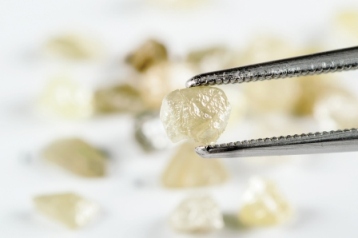IDEX Online Rough Diamond Market Report: Moody Market
August 06, 13
(IDEX Online News) – The dominant characteristic of the global rough diamond market is not economic. Nor is it a trend, a marketing issue, or technological. It is an emotional one. Sightholders, rough diamond dealers and many manufacturers remain in a bad mood. 
There are several reasons for the foul mood, and they are well defined: first-hand buyers of rough diamonds – Sightholders, for example – claim they are losing money; prices of rough offered by miners remain firm; prices of polished are declining; profitability is nil.
Added to this is a macroeconomic scene: a still delicate global economy and a poisonous rupee-US dollar exchange rate. From a manufacturer’s standpoint, micro-economic issues, namely changes in De Beers, exasperate this.
Many in the industry are pointing their finger at De Beers CEO Philippe Mellier. The general sentiment is that Mellier is “too” bottom-line oriented, focusing on the upcoming quarterly results, rather than long-term diamond industry needs.
At a recent meeting with him, he reiterated that the company is no longer the custodian of the industry, which can be understood to mean that it is not its responsibility to put the diamond industry ahead of the firm’s revenues. However, if the company operates from one balance sheet to the next, in the long-term it has a problem. De Beers is a diamond industry company and where the industry goes, so goes De Beers. If the industry heads downwards, so will a leading miner.
However, De Beers’ current approach, at least as it is understood by the industry, has its benefits as well. In the past, companies didn’t dare leave many goods on the table, if at all. At the last Sight, estimated at $650 million, some 15 percent of the goods (by value) were turned down. This, of course, reflects the high prices of the goods and smaller needs of manufacturers.
Why Buy Rough?
Prices did not change much during the July Sight, some boxes increased, some were priced a little lower. But the relatively high cost of goods and manufacturing, coupled with declining polished diamond prices, begs the question: why was 85 percent of the Sight bought, and why weren’t more goods turned down?
A partial answer is that Sightholders don’t want to lose their allocations in the future, fearing that their inability to deal with the goods today will be translated into an understanding that they can’t handle the goods. Some need to show turnover to their banks to keep their credit intact. At the end of the day, a business needs to operate, even if its profits from polishing are near 1 percent.
This last point should not be viewed as an obvious one. Once again we are hearing reports that money is leaving the industry, that owners of large companies prefer to decrease investment in the business and invest their money in other sectors.
Demand is Low
First-hand buyers trying to sell rough to the secondary market have found that most boxes are not selling, or “stuck” in the words of one broker. Must buyers are Indians, willing to pay 1-2 percent above list price according to one source, 2-3 percent according to another source, at 60-90 days credit.
These premiums are true not only for De Beers goods, but also for Alrosa’s, which is not pricing its goods as high as De Beers, yet are still priced high enough to be considered unprofitable.
The goods that are in demand are the large 5-15 carats color goods. There are mixed reports about demand for 4-8 grainers in VS-SI (commercial) goods. The 2.5-4 carats parcels are hardly moving.
August Sight Will Be Small
Sightholders have some flexibility as to when and how much of their allocation they get at each Sight. For the upcoming August Sight, Sightholders have delayed as much as 25 percent of their allocations. And, as far as we know, there are no requests for ex-plan goods (additional items beyond the scheduled allocation).
Demand for Key DTC Boxes following July Sight
| Article | Demand | Remarks on Demand |
| Fine 2.5-4 cts & Fine 5-14.8 cts | Low demand for 2.5-4 cts and Medium demand for 5-14.8 cts | Lower demand compared to previous Sight. Trading at list or just above list. |
| Crystals 2.5-4 cts & Crystals 5-14.8 cts | Low demand for both boxes. | Lower demand compared to previous Sight. Trading at list. |
| Commercial 2.5-4 cts and 5-14.8cts | Low demand for 2.5-4 cts and high demand for 5-14.8 cts | Same demand compared to previous Sight. 2.5-4 cts trading at low single digits and 5-14.8 cts trading at High single digits. |
| Spotted Sawables 4-8 gr | Medium demand | Same demand compared to previous Sight. Trading at low single digits. |
| Chips 4-8 gr | Medium demand | Same demand compared to last Sight. Trading at low single digits. |
| Colored Sawables 4-8 gr & Colored 2.5-14.8 cts | Medium demand for both sizes | Same demand compared to previous Sight. Trading at mid-single digits. |
| Makeables High 3 gr +7 | Medium demand | Better demand compared to last sight. Trading at low single digits above list. |
| Preparers Low 3-6 gr | Medium demand | Higher demand then last sight. Trading at mid-single digits. |
| 1st Color Rejections (H-L) +11/+7 | Very low demand | Same demand compared to previous sight. Trading at below list. |
| 1st Color Rejections (H-L) -7+3 | Low demand | Same demand as last sight. Trading at below list. |